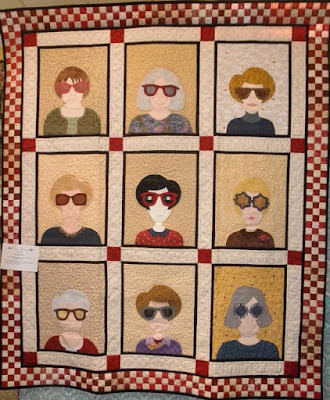I've been busy the last few days, cleaning 5 different sewing machines. These are all ready to stitch now.
First, I cleaned a Riccar Dressmaker Model RS-98. This was made in Japan, around 1989, and, is a free-arm machine. It came with attachments, but, no manual. I've contacted the company, and, hopefully, a manual will be headed this way soon. I do need the manual, since it stitches differently than my other machines, and, even setting the stitch length was hard to figure out. Once I get the manual, it will be simple to work. This is a metal machine, not a plastic machine.
 |
| 1989 Riccar Dressmaker Model RS-98 |
The second machine I worked on is for a friend's daughter. I should have cleaned this in July, but, I got it days before I hurt my hand, and, since this is a VERY HEAVY machine, I put off messing with it.
The lady I got it from said the tension would never work for her. I figured out why. There was a ball of lint between the bobbin case and the tension spring. I had to take it apart (tiny little screw I almost lost) and clean it out. It stitches nicely now. It came with lots of attachments and a manual.
 |
| Kenmore Green Zig Zag, 148.12050 (Model 1205) 1970-71 |
The next machine is also a Kenmore (Kenmore's are great machines). I got this earlier this month. It is very similar to the machine my mother had (now my son's machine). I learned how to quilt on my mother's old machine.
 |
| Kenmore 158.14301 (Model 1430) 1974-75 |
Today, I worked on 2 machines that got re-wired at the
Arkansas TOGA, the first week of October. Since I knew that they had to be re-wired before I could use either of them, I never cleaned them.
I got this machine, back in May 2012, from another collector in downstate Illinois. I was going to turn it into a hand crank (I still may). If I do, I'll find matching paint, and paint a spoked hand wheel and hand crank to match. I like that the motor, foot control and light are all matching (blue).
 |
| Home Mark Super Deluxe (C34422) Japan class 15 |
The last machine I worked on today was the dirtiest, by far.
 |
| look at all that oily lint |
 |
| drippy grease all over the bottom of the machine, yuk! |
I had to get all that old grease off the gears before I could start oiling the machine.
This is what my counter looks like, as I clean machines.
 |
| parts, parts, everywhere |
And this is what happens when a screw is stuck, and the screwdriver slips.
 |
| blood, blood everywhere |
Don't worry, I cleaned it up. It's hard to finish cleaning a machine with this on your hand.
This is the cleaned up machine. It was also re-wired at the Arkansas TOGA. It stitches very nicely.
 |
| Stitchmaster (DA201062) class 15, Made on Occupied Japan |
What started all my cleaning is that I have 2 different ladies who want to buy a hand crank from me. I needed pictures of the machines I would consider selling and converting to hand cranks. I knew the machines were in the dining room, but, I didn't know which machines they were. As I went thru all the machines in the dining room (22 machines, oh my!) I made a list of what I have in there, and labeled each machine case or cabinet. I still have to double check the machines for sale, and convert them to hand cranks.
Since I'm in a cleaning mood (gotta clean house before Thanksgiving) then I am planning on going thru all the machines in the living room, too. I have a couple in there that need to be cleaned.
Tomorrow is a sew-in day with my little quilt guild. I'm taking the last 2 machines, for other's to sew on (that is why I had to clean them today). The Green Kenmore will also be going, so that it can head to it's new home (that will leave 21 machines in the dining room). As for the 21 machines in the dining room, you'd never think I had that many machines in there. I have them 'hidden' in corners, on top of cabinets (with machines in them, too), under cabinets, etc. Don't worry, I have LOTS of room to get around my dining room table. Thank goodness for the bay window (most of the machines live there).































































